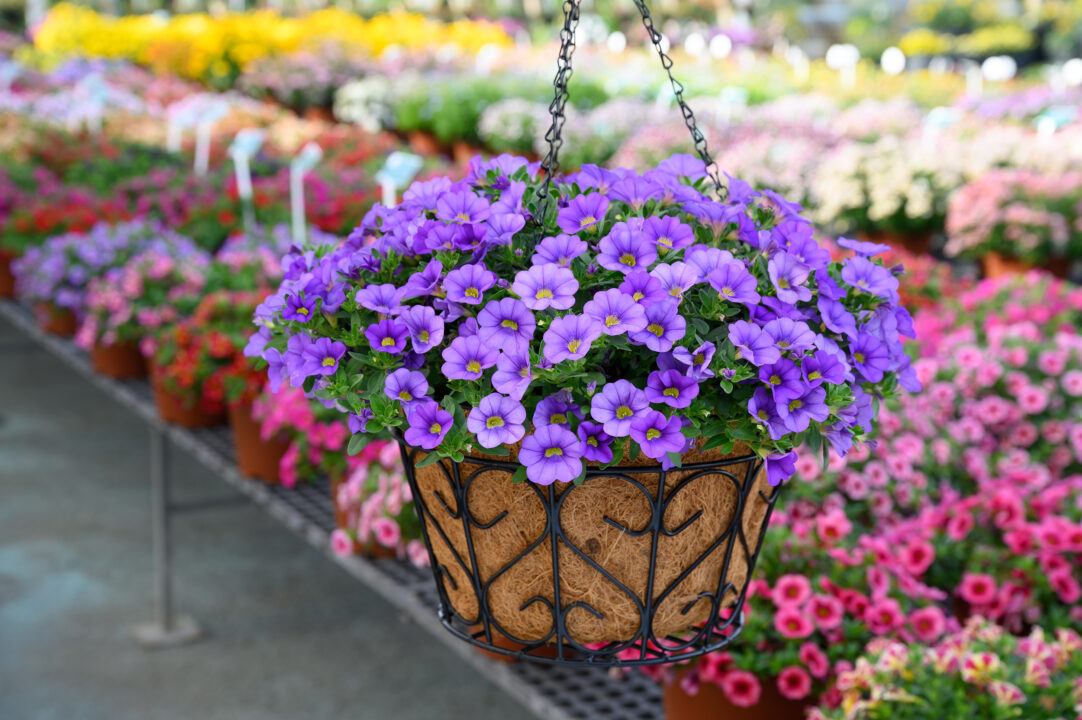The ‘Controlled Chaos’ of Transportation in Horticulture
Transportation and logistics can be one of the trickiest parts of horticulture. Growers go to great lengths to control everything about a plant’s environment for months. They give it the proper nutrients, light, and just the right amount of water. But what happens when it leaves the greenhouse? Well, anything could happen, which is why Ellis Ollinger, CEO of Flowerwood Nursery, wants to make sure it’s done right.
“We find plants that we think the consumer will appreciate. We market them and create demand for them, so when customers buy it, they are asking for it by name,” he says. “We take cuttings, we grow it for a year, and in many cases, we merchandise it when it gets to the store. Why would we not want to control the last leg of that journey?”
Tackling transportation and logistics is no easy task, especially during the spring shipping season. Here are a few hacks that growers across the country have found to increase efficiency and their bottom line.
Supermarket Saves Time and Labor
FlowVision has introduced lean flow practices to production and transportation in the horticulture industry. With its master pull concept, growers have been able to pull orders and load trucks in a fraction of the time, according to Executive Vice President and Founding Partner Gary Cortés.
Rather than pulling orders one at a time from the field or greenhouse, FlowVision suggests growers pull many orders at once to load multiple trucks and set up a supermarket. The supermarket could be a long row with many racks full of plants that were pulled from the greenhouses. A team member walks through the supermarket and “shops” for a specific order, just as a person would walk through a grocery store collecting items on his list.
Cortés says there are multiple ways to shop at a supermarket. One person could walk the entire supermarket and shop the whole order. However, the suggested method includes several team members doing the shopping. Using a Henry Ford assembly line technique, one person could shop racks 1-30 and another could shop racks 31-52, for example.
“By shopping a small portion of the supermarket, you remember where the plants come from in your area instead of having to learn the entire supermarket, even though the racks are numbered and it tells you where to go,” says Cortés. “The other advantage is not walking as much. You spend less time walking and more time shopping.”
The spring shipping season leads to many long nights, often as late as 2 a.m. during the peak season. Growers are looking to stop working until 2 a.m. and make their peak season feel like any other day of the year.
“Spring is very chaotic. After the employees have worked 14-hour days for six weeks in a row, they can’t take it anymore and the quality suffers because they’re tired,” Cortés says. “We’ve had implementations where they worked until 2 a.m., and when we implemented the supermarket concept, they finish at 6 p.m. The number of people and number of shipping trucks does not change, but the hours worked goes down drastically.”
In the spring whirlwind, sometimes items may be incorrectly picked and shipped to retail customers. The supermarket system also reduces the number of errors because plants go through three checkpoints. The first check is making sure the correct plant is pulled from the greenhouses. The second check is when the plant is pulled in the supermarket. The third check takes place at the processing tables, where the team compares the plants pulled to the rack sheet as they are tagged and labeled.
‘Controlled Chaos’ at Corso’s Horticulture
Troy Slauterbeck is the Logistics Manager for Corso’s Horticulture in Sandusky, OH, (Corso’s was Greenhouse Grower’s Operation of the Year winner in 2022) and refers to spring shipping at the operation as “controlled chaos.” Corso’s ships to nine states across the Midwest and Northeast. From March to September 2023, the operation shipped 8.18 million plants, according to Shipping Manager Deborah Burton.
Corso’s has implemented the supermarket concept, and there are 61,000 plants per supermarket. Each supermarket includes 700-750 carts, which equals about 645 shipping carts. Pulling plants for the supermarket takes two to three hours, and cleaning the pulled plant material takes another two hours. A truckload is “shopped” from the supermarket in 15 minutes, and the plants are scanned, audited, wrapped, and loaded in 20-25 minutes.
One of the most efficient changes came with resolving a bottleneck in the loading dock. Racks that were being pulled for the supermarket were in the same area as racks that had already been picked and were sitting in scanning lanes. The intersection had too much traffic, and it was slowing everyone down. By relocating the scanning lanes, traffic flowed freely again.
“It was a minor change, but it really improved our efficiency and productivity,” says Slauterbeck.
He also found efficiencies in tweaking the routing software. For example, the routing software may come up with a route to Burlington, IA, and it sends the driver to the farthest location first. Then the driver would make the rest of the deliveries on his way back. Slauterbeck may change it to do the opposite to pick up racks on time. The last location on the list could be accumulating empty racks, so he wants the driver to go to that one first instead.
He also makes an effort to keep in communication with the drivers. Slauterbeck started his career as a driver and later owned his own trucking company. He says his door is always open and the drivers are welcome to come in and chat when they come to Corso’s. Slauterbeck says he treats the drivers the way that he would want to be treated.
“I know most of my drivers on a first-name basis,” says Slauterbeck. “I feel that I get 110% better service based on the relationship that Corso’s and I have with them.”
Trucking at Flowerwood Nursery
Ellis Ollinger, CEO of Flowerwood Nursery, says he pays close attention to the trucking line item on their income statement. Transportation is the second largest cost for Flowerwood Nursery behind labor. To maintain its high-quality customer service, Flowerwood developed a separate entity to operate as a trucking company, Flowerwood Trucking, and a brokerage company, Loxley Logistics. The company owns 50 trucks and 175 trailers with a liftgate. Each truck runs for five years (about 650,000 miles) and then is sold.
“I have as many trucks as I can afford on my slowest day,” Ollinger says. “Usually, I end up with twice as many as I need on my slowest day, but half as many as I need on my busiest day. That’s what you can afford to keep busy year-round.”
During the off-season, Flowerwood’s trucks haul freight for other local customers to keep the drivers busy. Off-season freight includes peanuts, aluminum, cardboard, and air filters.
“You’re at the mercy of the market when you do that. You’re picking up someone else’s excess freight,” says Ollinger. “You’re not getting the best rates, but you’re helping to defray your yearly cost.”
When the grower also owns the trucks, you get into the business of reverse logistics. Once the plants are delivered, the driver is given a new route to come back and pick up empty racks.
“You can’t sling out racks everywhere and not worry about where they are,” says Ollinger. “If you don’t get them back quickly, they disappear.”
Flowerwood Nursery has developed a “no-leave list” for its racks. If racks are lost too often at certain stores, that location is placed on the no-leave list. Flowerwood pays the driver to “lump,” which means to unload the racks at the customer and put them right back on the truck. Some customers say that the racks are left at the store too long. In those cases, Flowerwood also keeps the racks on the truck.
“It’s expensive, so it’s not for the faint of heart,” Ollinger says of operating a trucking company. “Get your checkbook ready. But for us, it’s all about customer service.”
The Benefits of Consolidation
In addition to supplying rented racks to many growers, Container Centralen (CC) operates a cross dock in Atlanta, GA. Many growers have found this to be more cost-effective for their operation than working with contract carriers. Craig Roth, President of Sunshine Growers in Lakeland, FL, gives an example.
Sunshine Growers may ship a semi full of plants to CC’s depot in Atlanta. From there, the plants are distributed into box trucks for delivery at each store in the Atlanta area. Sunshine Growers primarily sells to Publix and Costco.
“CC took our order on a semi and separated it on small box trucks and delivered to more stores in a shorter amount of time than what a semi could do. The efficiency and speed with which they deliver is better,” says Roth.
Roth explains the benefits of using the cross dock in Atlanta as “a simple math equation.” He says Sunshine Growers could deliver plants in a semi from central Florida to the depot in Atlanta for $1,250. If the semi went to six stores in Atlanta instead of the depot, it would cost $2,000 more.
“If I cross dock, I deliver for $1,250. CC delivers to the stores for $1,000, and I save $750 for each truck,” Roth says. “Not only are they making it more efficient, but they’re also picking up racks, and they’re saving me money. It’s a win-win.”
No matter how much we wish for it, there is no crystal ball for transportation and logistics. Each grower and retailer is a little different, so there will always be nuances. But it is important to keep an open mind to the many options available in the transportation industry, ranging from rented racks to owning your own trucks to using a cross dock. Whatever you choose, everyone wins when it is “controlled chaos.”



























